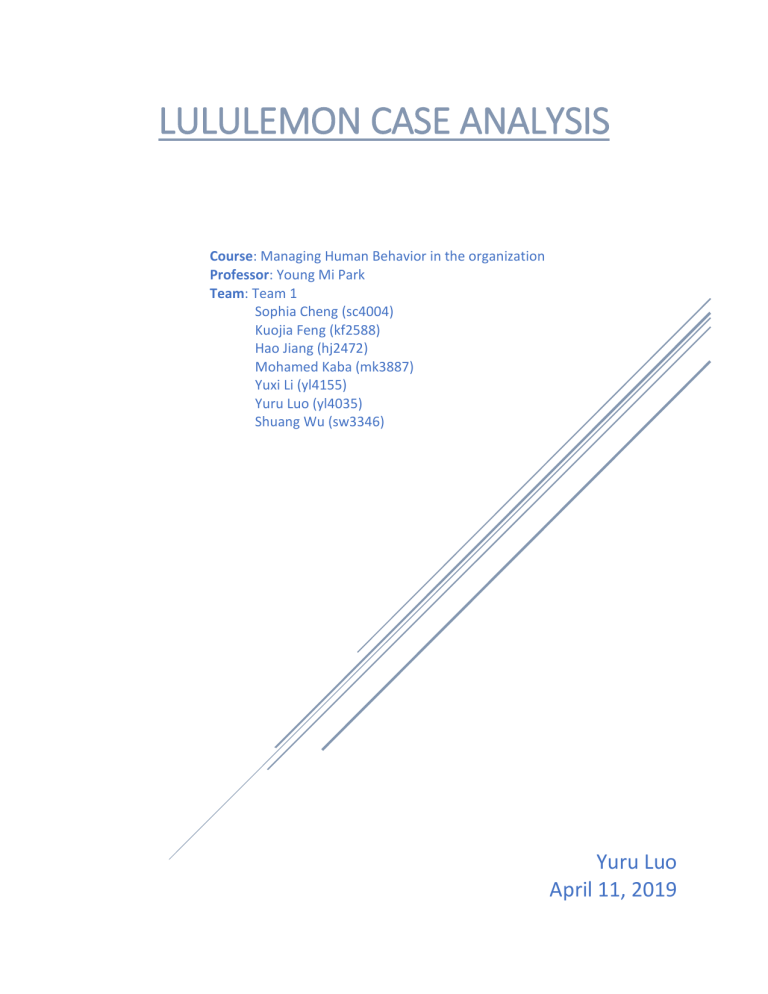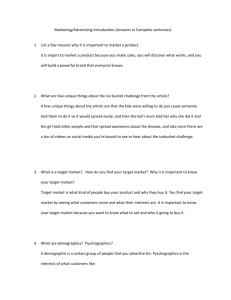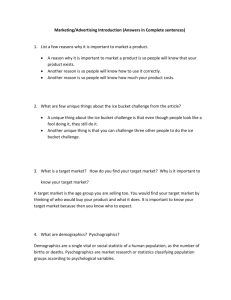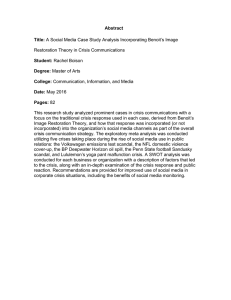
LULULEMON CASE ANALYSIS Course: Managing Human Behavior in the organization Professor: Young Mi Park Team: Team 1 Sophia Cheng (sc4004) Kuojia Feng (kf2588) Hao Jiang (hj2472) Mohamed Kaba (mk3887) Yuxi Li (yl4155) Yuru Luo (yl4035) Shuang Wu (sw3346) Yuru Luo April 11, 2019 Lululemon case analysis Part 1: Executive Summary Lululemon multimedia case describes the company’s current situations and performance in 2008 with its new CEO, Christine Day, who aimed to build Lululemon as a “billion-dollar company”. As details of stakeholders, company culture and management structure unfold in the case, it is evident that Christine was facing new challenges related to human and real estate issues to achieve the goal. Given the evolving situation, as Lululemon attempts to expand globally, the question arises as to whether Christine can address issues related to human resources, make effective decisions on future development at this critical moment, and finally help Lululemon improve performance. This paper was ordered in a Situation-Analysis-Action order. To let readers better understand the issues addressed and recommendations given in the paper, a brief summary of relevant background information is stated first. Then, SWOT and Porter’s Five Forces analysis are conducted to evaluate inside and outside challenges of Lululemon and provide insight for possible action plans. Finally, combining concepts in Organizational Behavior, recommendations composed of communication, negotiation, and conflict solving with different groups of stakeholders and expected results are given from Christine’s perspective. Part 2: Introduction • History Founded by Chip Wilson in Vancouver, Canada in 1998, Lululemon is a yoga-inspired, technical athletic apparel company for women and men. The company went public in 2007 and raised a total amount of $327.6 million. In January 2008, Christine Day, a former executive of Starbucks International, was hired as SVP of retail and was identified as CEO Bob Meers’ heir apparent. • Structure and culture Running with a top-to-bottom structure and a vertical sale model, Lululemon has developed the ability to control pricing and quality. Major decisions are passed from Store Support Center (SSC), but store managers are still allowed to expand the brand and make local decisions. Their performance is directly related to 20% of compensation. With a vision of elevating the world from mediocrity to greatness and providing qualified products for people to live longer, healthier and with more fun, Lululemon embraces a healthy and active culture by emphasizing on integrity, work-life balance, and even the importance of having fun. To make employees actively live and breathe its culture and lifestyle, Lululemon requires every worker, from the C-suite to the accountants to the design team, to spend at least eight hours a month working in stores. • Performance and problems From 2005 to 2008, Lululemon has experienced a sharp increase by doubling sales every year and prompting net income to $30 million. However, for Christine Day, there are still some problems to be solved. First, the stock price of Lululemon, highly concerned by the board, is in a huge fluctuation: from $18 at IPO to $60 and now to $31. Besides, due to persistent inventory problems, its aggressive expansion to the U.S. led to a lot of store closures and thus high costs. Last but foremost, the company is working at low efficiency because its leadership team was pg. 1 Lululemon case analysis demoralized and fragmented. The cultural shifts caused by bring-in of several outsiders by Bob to form his upper management team caused growing pains to leadership and teamwork. Therefore, professionals brought in failed to be on board and other board members failed to cooperate with Bob’s management team. Part 3: Company Analysis Basic SWOT analysis of Lululemon plays an important role in determining the action plan as this analysis enables the company to understand, interpret, and develop itself against its competitors. The collected analysis should also provide insight into potential competitive actions and prepare the company to address forthcoming threats and take advantage of opportunities. SWOT analysis Category Strength Illustration Mission Carry out “components for people to live longer, healthier, more fun lives.” Culture Emphasis on integrity and work-and-life balance. High demands-oriented products “F” factor in its sportswear: emphasizing “fit” and “function,” but steering clear of the term “fashion”. Employee management Systemic and progressive training; Motivated compensation structure. Weakness Underperforming stores: real estate issues in the United States High-cost locations in many of the new U.S. markets with little to no demand; Inventory problems Growth was outpacing the development of infrastructure and operational systems; Poorly supervised construction at many sites caused escalating costs and quality concerns. Pay extra to ship out-of-stock items by air and struggle to implement new inventory systems. Opportunity pg. 2 Eroded teamwork (crossfunctional barriers) Demoralized and fragmented leadership team resulted in an inability to achieve compromise. Local decision making Customized brand extension by store managers involved certain risks. Cultural shift The hiring of Former Reebok Chairman Bob Meers as CEO, who in turn brought in several outsiders to form his upper management team. Lululemon case analysis Company performance under the current macro environment Fluctuated stock price: $18 at IPO to $60 to $31. Decreasing consumer confidence and growing uncertainties in global markets; Cash-strapped U.S. customers. Threats Competitors Inroads in the yoga apparel market by competitors such as Nike, Adidas and Under Armour. Further analysis of Porter’s Five Forces model reveals the intensity of rivalry in the sports apparel industry. • • • • • Threat of new entry: Lululemon is facing high-level threats from new competitors mainly due to relatively low entry barriers in clothes retailing. A large number of emerging apparel companies might take up Lululemon’s market shares. Threat of substitution: As Yoga enthusiasts need exactly the features of athletic apparel, there are few alternatives. Lululemon faces low-level threats of substitution. Bargaining power of suppliers: The key suppliers of Lululemon locate in the AsianPacific region, which poses potential environmental and political risks. The concentration of suppliers increases their bargaining power and any disruption in supply or cost increases might impede Lululemon’s ability to maintain its operation. Bargaining power of buyers: Customers of Lululemon keep a moderate level of bargaining power. They are facing low switching costs and a large number of product options across the pricing spectrum. However, brand distinction and customer loyalty enable Lululemon to charge premium prices for its products. Competitive rivalries: The intensity of rivalries is increasing due to a large number of new entrants, so competitive rivalries pose huge threats to Lululemon. Its main competitors, such as Nike, have significant resources and staying power to earn a solid share of the market, at Lululemon’s potential peril. Porter’s Five Forces Threat of new entry: high Threat of substitution: low Competitive rivalries: increasing Suppliers power: high pg. 3 Buyers power: moderate Lululemon case analysis In conclusion, Lululemon’s value proposition, its view of its customer, and its vertical retail model set it apart in an industry sector largely dominated by wholesalers, such as Nike and Adidas. At the same time, with Christine Day taking office as the new CEO, Lululemon is facing problems with an aggressive extension to the U.S. and setting the tone of the management on a new level. Christine is expected to carry out decisions based on evaluations about the current performance and weakness of the company. Part 4: Recommendations and Expected Results Based on SWOT and Porter’s Five Forces analysis above, a general picture of situations Lululemon is facing both inside and outside is generated. In a major context of Organizational Behavior, the analysis is also helpful to make further recommendations. From the perspective of new CEO Christine, there are mainly three components of recommendations to achieve the goals stated. Shareholders Methods Expected Results Board members and senior management Include all senior managers in strategies making meetings and take strategies to board voting before putting into practice. Avoid errors and biases on individual decision making. Accounting department Require financial analysis on company performance against its competitors and profits breakdown based on all stores in the U.S. Shut down stores with few revenues and high costs in the U.S. and solve inventory problems. Sales department Talk to representatives of store managers and learn history loss due to local brand extension. Control risks relating to customized local decisions made by store managers. Customers Encourage store managers to educate customers on values and technical features of Lululemon’s products. Develop brand loyalty and charge a premium. Senior management Learn compensation structure of all employees and adjust if their motivations are not aligned with the company’s long-term goal. Carry out a win-win solution and set an aligned culture across the company. Communication Negotiation pg. 4 Lululemon case analysis Board members brought in by Bob Meers Conflicts Solving Develop deep listening with these board members: explore their emotions and expand their thoughts. It is important to know the conflicts of interest between them and other members and align their motivations with the company’s values. Increase trust between each other and prevent or defuse conflicts. Finally, a good mix of internal and external experts is expected. Part 5: Conclusion Lululemon is at a critical moment in its expansion history with new CEO – Christine Day. Outside challenges include aggressive expansion to the U.S. and an increasing number of competitors in the sports apparel industry while inside challenges mainly relate to teamwork and relationship with board members. To address the problems and make Lululemon a billion-dollar company, Christine Day needs to carry out effective internal control actions, which include communication, negotiation, and conflicts solving with various stakeholders. These actions are expected to solve performance and teamwork problems by applying Organizational Behavior concepts and improve Lululemon’s performance in the market against its competitors. pg. 5





